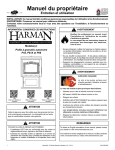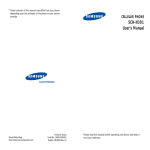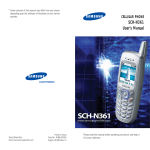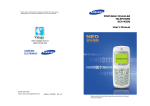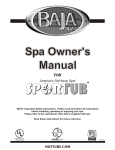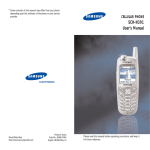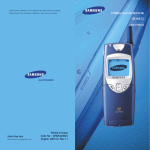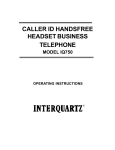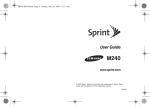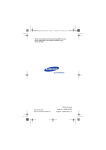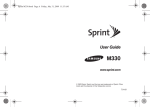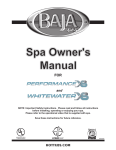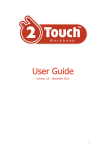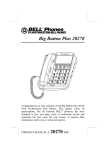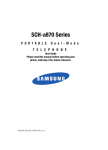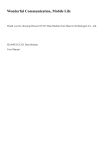Download PORTABLE CELLULAR TELEPHONE SCH
Transcript
* Some of the contents of this manual may differ from your phone, depending on the software installed or your service provider. PORTABLE CELLULAR TELEPHONE SCH-N415 User’s Manual ELECTRONICS World Wide Web http://www.samsungmobile.com Printed in KOREA Code No.: GH68-06798A English. 02/2005. Rev.1.0 Please read this manual before operating your phone, and keep it for future reference. 1 Table of contents Table of contents Important safety precautions .......................7 Unpacking .....................................................9 Your phone .................................................10 Phone layout...................................................... 10 Display.............................................................. 13 Backlight ........................................................... 15 Getting started............................................16 Using the battery................................................ Switching on or off the phone............................... Using the soft keys ............................................. Your phone’s modes............................................ 16 20 21 22 Call functions ..............................................24 Making a call...................................................... Ending a call ...................................................... Emergency dialing .............................................. Using the recent call logs..................................... Making a call from Phone Book ............................. Prepend dialing .................................................. Speed dialing ..................................................... 4-digit dialing..................................................... Pause dialing ..................................................... Adjusting the volume during a call ........................ Answering a call ................................................. Silencing a call ringer.......................................... Viewing missed calls ........................................... Options during a call ........................................... Using caller ID ................................................... Call forwarding................................................... Call waiting........................................................ Three-way calling ............................................... 24 25 25 26 26 27 27 29 29 33 34 34 35 36 37 37 38 39 3 Table of contents Table of contents Entering Text ..............................................40 Planner .......................................................71 Changing the text input mode .............................. Using T9 (English) mode...................................... Using Alphabet mode .......................................... Using Symbol mode ............................................ Using Number mode ........................................... Today (Menu 4-1) ............................................... Scheduler (Menu 4-2) .......................................... Task List (Menu 4-3) ............................................ Memo Pad (Menu 4-4).......................................... Alarm (Menu 4-5) ................................................ Calculator (Menu 4-6) .......................................... World Time (Menu 4-7) ........................................ Countdown (Menu 4-8) ........................................ Set Time (Menu 4-9) ........................................... 41 42 44 46 46 Using the menus .........................................47 Accessing a menu function by scrolling .................. 47 Using shortcuts .................................................. 48 List of menu functions ......................................... 49 Calls ............................................................52 Outgoing (Menu 1-1) ........................................... Incoming (Menu 1-2) ........................................... Missed (Menu 1-3)............................................... Erase History (Menu 1-4) ..................................... Air Time (Menu 1-5) ............................................ 52 53 54 54 55 Phone Book.................................................56 Find (Menu 2-1) .................................................. Add New Entry (Menu 2-2) ................................... Group Setting (Menu 2-3)..................................... My Phone# (Menu 2-4) ........................................ Memory Info (Menu 2-5) ...................................... 56 58 61 62 62 Messages ....................................................63 New MSG (Menu 3-1)........................................... Voice (Menu 3-2) ................................................ Inbox (Menu 3-3) ................................................ Outbox (Menu 3-4) .............................................. Filed MSG (Menu 3-5) .......................................... WAP Alert (Menu 3-6) .......................................... Erase MSG (Menu 3-7) ......................................... MSG Setting (Menu 3-8) ....................................... 4 63 65 66 67 67 68 68 69 71 73 75 76 78 79 79 80 81 Voice Tools..................................................82 Voice Memo (Menu 5-1) ....................................... 82 Voice Answer (Menu 5-2) ..................................... 83 Sounds ........................................................86 Ringer Volume (Menu 6-1).................................... Ringer Type (Menu 6-2) ....................................... Alerts (Menu 6-3) ................................................ Key Tone (Menu 6-4) ........................................... Roam Ringer (Menu 6-5) ...................................... Power On/Off (Menu 6-6) ..................................... 86 87 88 88 89 89 Display ........................................................90 Menu Style (Menu 7-1) ........................................ Wallpaper (Menu 7-2) .......................................... Backlight (Menu 7-3) ........................................... Banner (Menu 7-4) .............................................. Dual Clock (Menu 7-5) ......................................... Contrast (Menu 7-6) ............................................ Power Saving (Menu 7-7) ...................................... 90 90 90 91 91 92 92 Games.........................................................93 Fun Bowling (Menu 8-1) ........................................ 93 Honey Ball (Menu 8-2) ......................................... 94 Go Hamster (Menu 8-3) ....................................... 96 5 Table of contents Setup ..........................................................97 Answer Method (Menu 9-1).................................... 97 Auto Key Lock (Menu 9-2) .................................... 98 Auto Retry (Menu 9-3) ......................................... 98 Data/Fax (Menu 9-4) ........................................... 98 Version (Menu 9-5)............................................ 100 Security (Menu 9-6) ........................................... 100 Downloads ................................................104 WAP ..........................................................106 Launching the WAP Browser............................... Navigating the WAP Browser .............................. Entering Text in the WAP Browser....................... Using the Browser Menu Options ........................ 106 106 107 107 Health and safety information...................109 Exposure to radio frequency (RF) signals ............. Road safety ..................................................... Operating environment ..................................... Electronic devices ............................................. Potentially explosive environment ....................... Emergency calls ............................................... Other important safety information ..................... Care and maintenance ...................................... 109 113 114 114 116 117 118 119 Glossary ....................................................121 Quick Reference Card................................125 6 Important safety precautions Read these guidelines before using your wireless phone. Failure to comply with them may be dangerous or illegal. Road safety at all times Do not use a hand-held phone while driving; park the vehicle first. Switching off when refuelling Do not use the phone at a refuelling point (service station) or near fuels or chemicals. Switching off in an aircraft Wireless phones can cause interference. Using them in an aircraft is both illegal and dangerous. Switching off in near all medical equipment Switch off your phone near medical equipment. Hospitals and health care facilities may be using equipment that could be sensitive to external RF energy. Follow any regulations or rules in force. Interference All wireless phones may be subject to interference, which could affect their performance. Special regulations Follow any special regulations in force in any area and always switch off your phone whenever it is forbidden to use it, or when it may cause interference or danger (in a hospital for example). Water resistance Your phone is not water-resistant. Keep it dry. 7 Important safety precautions Unpacking Sensible use Use only in the normal position (held to the ear). Avoid unnecessary contact with the antenna when the phone is switched on. Your package contains the following items. The illustrations below may look different from your phone and accessories: Emergency call Key in the emergency number for your present location, then press . Give all necessary information as accurately as possible. Do not end the call until given permission to do so. Keeping small children away from your phone Handset Battery Travel adapter User’s manual Keep the phone and all its parts including accessories out of reach of small children. Accessories and batteries Use only Samsung-approved accessories and batteries. Use of any unauthorised accessories could damage your phone and may be dangerous. Use only Samsung-approved batteries and recharge your battery only with Samsung-approved chargers. In addition, you can obtain the following accessories for your phone from your local Samsung dealer: • Headset • Travel adapter Qualified service • Standard battery • Cigarette lighter adapter Only qualified service personnel may repair your phone. • Hands-free car kit • Data cable • Holster For more detailed safety information, see “Health and safety information” on page 109. CAUTION RISK OF EXPLOSION IF A BATTERY IS REPLACED BY AN INCORRECT TYPE. DISPOSE USED BATTERIES ACCORDING TO THE INSTRUCTIONS. 8 9 Your phone Your phone Key Key(s) Phone layout The following illustrations show the main elements of your phone. (soft keys) Description Performs the functions indicated by the text above them, on the bottom line of the display. In Menu mode, scrolls through menu options. In Standby mode, allows you to allows you to enter the WAP menu, allows to enter the Messages menu, allows to enter the Scheduler menu. (Navigation enter the Downloads menu, keys) Earpiece In Standby mode, accesses the Downloads/WAP menu. Headset jack Display Volume/menu browse keys Navigation (Up/ Down/Left/ Right) keys OK key Makes or answers a call. In Standby mode, retrieves the most recent numbers dialed, received, or missed. Redials the last number when pressed and held. Soft key (left) Soft key (right) Ends a call. Also switches the phone on and off when pressed and held. Send key Power on/off/ Menu exit key In Menu mode, cancels your input and returns the display to Standby mode. Cancel/clear key Alphanumeric keys Special function keys Microphone Deletes characters from the display. In Menu mode, returns the display to the previous menu level. Enters numbers, letters, and some special characters. Interface Connector 10 11 Your phone Key(s) Your phone Description (continued) Display In Standby mode, activates Key Lock mode when pressed and held. Layout In the text entry mode, changes case of letters. In Standby mode, quickly enters or exits Silent mode when pressed and held. The display has three areas; the top line of icons, the text and graphic area, and the bottom line of soft key indicators. Icons In the text entry mode, inserts a space. Text and graphics area (on the left side of the phone) During a call, adjusts the voice volume. In Standby mode, adjusts the key tone volume. Menu Find Soft key function indicators Icons Icon Description Signal strength: Shows the received signal strength. The greater the number of bars, the better the signal. Service: Appears when a call is in progress. No service: Appears when you are outside a service area. When it displays, you cannot make or receive calls. Wait a little while for a better signal or move into an open area to regain service. 12 13 Your phone Icon Your phone Description (continued) New text message: Appears when a new text message received. Backlight New voice mail: Appears when a new voice mail is received. The display is illuminated by a backlight. When you press any key, the backlight comes on. It goes off if no keys are pressed within a given period of time, depending on the setting in the Backlight menu (Menu 7-3). New WAP push message: Appears when a new WAP push message is received. To specify the length of time for which the backlight is active, set the Backlight menu; see page 90 for further details. Alarm mode: Appears when you set an alarm to ring at a specified time. Roaming: Appears when you are out of your home area and have logged onto a different network; for example, when traveling in other countries. Ringer on: Appears when you set the ringer volume for calls to one from Level 1 to Level 8 or to 1-Beep. Ringer off: Appears when you set the ringer volume for calls to Silent. Vibration mode: Appears when the ringer volume for calls is set to Vibrate or High + Vib, or when your phone is in Silent mode. Digital mode: Indicates when the phone is logged onto a digital network. 1x mode: Indicates when the phone is in 1x digital mode. Battery status: Shows the level of your battery. The more bars you see, the more power you have remaining. 14 15 Getting started Getting started Using the battery 2. Press the battery until it clicks into place. Make sure that the battery is properly installed before switching the phone on. Your phone is powered by a rechargeable Li-ion battery. Use only approved batteries and chargers. Ask your local Samsung dealer for further details. Note: You must fully charge the battery before using your phone for the first time. A discharged battery is fully recharged in approximately 180 minutes for a standard battery. Installing the battery 1. Place the battery so that the tabs on the end align with the slots at the bottom of the phone. Removing the battery 1. If necessary, switch off the phone by pressing and holding until the power-off image displays. 2. Slide the battery lock toward the top of the phone and lift away the battery, as shown. Charging the battery A travel adapter is provided for charging your batteries. The travel adapter allows you to use the phone while the battery is charging, but this will cause the battery to charge more slowly. 16 17 Getting started Getting started 1. With the battery in position on the phone, plug the connector of the travel adapter into the jack at the bottom of the phone. Make sure that the arrow on the connector is facing up, as is the phone. 2. Plug the adapter into a standard AC wall outlet. The battery strength icon on the display shows that the battery is charging. Low battery indicator You can easily tell if your battery needs to be recharged by checking the Battery Status icon( ) at the upper-right corner of your phone’s display. The presence of all three bars indicates a full charge, two bars indicates a smaller charge, and one bar indicates an even smaller charge. When the battery charge level becomes low, the battery sensor blinks an empty Battery Status icon ( ) and sounds a warning tone. If the battery level becomes too low, the phone automatically turns off. When this happens, you lose whatever you are doing and if in a call your phone call cuts off. Watch the Battery Status icon and make sure that your battery is adequately charged. 3. When charging is finished, unplug the adapter from both the power outlet and the phone by pressing the buttons on both sides of the connector and pulling the connector out. Note: You must unplug the charger before removing the battery from the phone during charging; otherwise, the phone could be damaged. 18 19 Getting started Getting started Switching on or off the phone Using the soft keys 1. Press and hold until the power-on image displays to switch on the phone. When the system locates services, the greeting message displays along with the time and date. You can now place and receive calls. Your phone offers a set of functions that allows you to customize it. These functions are arranged in menus and submenus, accessed using the two soft keys, and . Each menu and submenu allows you to view and alter the settings of a particular function. If the phone is out of service, the No Service icon ( ) appears on the display. In this case, you cannot place and receive calls. You can try again later when service is available. The roles of the soft keys vary depending on the current function you are using; the labels on the bottom line of the display just above each key indicate their current role. 2. When you wish to switch off the phone, press and hold for more than two seconds until the power-off image displays. Example: WARNING! Do not switch on the phone when mobile phone use is prohibited or when it may cause interference or danger. Note: As with any other radio-transmitting device, do not touch the antenna unnecessarily when the phone is switched on. Contact with the antenna affects the call quality and may cause the phone to operate at a higher power level than otherwise needed. 9:43A Tue 04 May Menu Press the left soft key to access Menu mode. 20 Find Press the right soft key to find a name or number from Phone 21 Getting started Your phone’s modes Standby mode Standby is the most basic state of your phone. The phone goes into Standby mode after you turn it on or whenever you briefly press . When your phone is in Standby mode, you will typically see the greeting message and the current time and date. If you enter a phone number, you can press to dial it or press to save it in Phone Book. Press at any time to return to Standby mode. Be careful; if you are on a call when you press , the call disconnects and the phone returns to Standby mode. Talk mode You can place and answer calls only when your phone is turned on. During a call, the phone is in Talk mode. While you are in Talk mode, pressing the Menu soft key gives you a list of options. See page 36 for details. Power Save mode Your phone comes with a Power Save feature that is automatically activated if your phone is unable to find a signal after 15 minutes of searching. While this feature is active, the phone’s battery charge is conserved. The phone automatically rechecks for a signal periodically. To manually force the phone to recheck for a signal, press any key. Getting started Lock mode When you lock your phone using the Lock Phone menu (Menu 9-6-1) in the Security menu, you cannot use the phone. In Lock mode, you can receive messages and calls, but you cannot place an outgoing call until you unlock the phone. To unlock the phone, you need to enter the lock code. For details about locking and unlocking your phone, see page 100. Silent mode Silent mode disables all sounds on the phone. This feature is best used in situations where the phone might disturb others, such as in a meeting, in a library, or in a theater. Your phone can be set to Silent mode with a press of a key in Standby mode. In Standby mode, press and hold until “Enter! Silent Mode” and the Vibration icon ( ) display. To exit and reactivate the previous sound settings, press and hold until “Exit! Silent mode” appears. The Vibration icon no longer displays. Key Lock Mode You can lock the keypad by pressing and holding in Standby mode. By doing this, you can prevent accidental key pressing To unlock the keypad, press and then hold . When you have an incoming call or an alarm occurs in Key Lock mode, the mode is automatically deactivated and the phone goes to Standby mode. Note: You can set the phone to automatically lock the keypad after a specified period of time, in the Auto Key Lock menu (Menu 9-2). See page 98. 22 23 Call functions Call functions Making a call In Standby mode, enter the area code and phone number and press . Note: When you have activated the Auto Retry menu (Menu 9-3), the phone will automatically retry to make the call if no one answers or the line is busy. See page 98 for further details. While entering a number, press the Menu soft key to use the following menu options: 4-digit Dial: allows you to use the 4-digit Dialing feature. This option is only available when you enter 4 digits. For details, see page 29. Speed Dial: allows you to use the Speed Dialing feature. This option is only available when you enter a number corresponding to a location in Phone Book. For details, see page 27. Find: finds a number from Phone Book. Hard Pause: enters a hard pause. 2sec Pause: enters a 2-second pause. Talk: places a call to the number. Save: saves the number to Phone Book. 24 Correcting the number To clear the Press last digit displayed whole display . and hold it for more than one second. Ending a call When you want to end your call, press . The length of the call displays along with the phone number of the called person. If the number is stored in your Phone Book, the name displays. If there is no match, you can press the Menu soft key and store the number in Phone Book. For further details about storing the number in Phone Book, see page 58. Emergency dialing You can place calls to standard emergency numbers on the Emergency # list, even if your phone is locked or all of the outgoing calls are restricted. For further details about emergency numbers, see page 101. 25 Call functions Call functions Using the recent call logs Prepend dialing The phone stores up to 60 of the calls you have dialed, received, or missed chronologically. The last call is saved in the first position. The Prepend option lets you add digits, such as area codes and network feature activation codes, to a phone number that is in your call logs or Phone Book. To recall any of these numbers: 1. If there are any characters on the display, return to Standby mode by pressing . 2. Press . The list of recent calls displays. The following icons indicate the types of calls: • : Outgoing calls • : Incoming calls • : Missed calls 1. Access a call log in the Call logs list by pressing . 2. Select the item you want using the Navigation keys and press the Menu soft key. The display shows the details of the number. 3. Press the Menu soft key to access the menu pop-up list. 3. Press the Navigation keys or the Volume keys on the left side of the phone until you find the number you want. 5. Enter the area code or network feature code. 4. Press 6. Press to dial the highlighted number. 4. Press to select the Prepend option. to dial the number. Making a call from Phone Book Speed dialing You can store the phone numbers you called regularly in the phone’s memory, which is called “Phone Book”. You then simply recall the number to dial. Once you have stored phone numbers in Phone Book, you can dial them easily with a few presses of the keys. For further details about the Phone Book feature, see page 56. 26 To prepend a phone number stored in your phone: Note: When several numbers are saved in one name entry, the first number you entered is automatically specified as a speed dial number. To change the speed dial number, use Speed dial of the Phone Book options; see page 59. 27 Call functions Call functions One-touch dial Memory locations 001 through 009 are special onetouch locations. You can dial the phone numbers stored in Phone Book from 001 through 009 simply by pressing one key. 4-digit dialing Press and hold the third digit of the memory location. You can quickly dial a phone number in Phone Book by entering its last 4 consecutive digits. This feature is convenient if you have the number memorized, but you have forgotten where the number is stored in your Phone Book. For example: Location no. 009 Press and hold . 1. Enter the last 4 digits of the phone number you want to dial. The number (and name) stored displays, and then dials. 2. Press the Menu soft key and select the 4-digit Dial option. The phone displays the phone number that matches the four digits. Two-touch dial Memory locations 010 through 099 are special twotouch locations. Press the second digit(s) briefly, then hold down the last digit of the memory location. For example: Location no. 023 Press briefly and hold down If the phone found more than one number that contains those four digits, it displays the first number. Scroll through the numbers using or to select a number. 3. Press . The number (and name) stored displays, and then dials. to dial the number. Pause dialing Memory locations 100 through 500 are special three-touch locations. When you call an automated system, like a banking service, you are often required to enter a password or account number. Instead of manually entering the numbers each time, you can store the numbers in your Phone Book, separated by pauses. Press the first two digit(s) briefly, then hold down the third digit of the memory location. There are two kinds of pauses that can be entered on your phone: For example: Location no. 123 Press and hold down . • Hard pause: A hard pause stops the dialing sequence until you press . Three-touch dial briefly, then The number (and name) stored displays, and then dials. 28 29 Call functions Call functions Pause dialing from a stored Phone Book entry • 2-sec pause: A 2-second pause stops the dialing sequence for 2 seconds and then automatically sends the remaining digits. Note: Multiple two second pauses can be entered to extend the length of a pause. Keep in mind that pauses count as digits towards the 32 digit dialing maximum. Storing pauses in a Phone Book entry To store a number in your Phone Book that contains pauses: 1. Enter the phone number you want to store, such as the bank’s teleservice phone number. 1. Dial the number of the service from Phone Book. 2. If you stored the number using a hard pause, wait for the appropriate prompt from the number you are calling. When prompted, press to send the DTMF (Dual tone multifrequency) number that follows the pause. If you stored the number using a 2-second pause, your phone transmits the number that follows the “T” pause two seconds after the connection. 2. Press the Menu soft key to access the options. 3. “Sending DTMF” flashes on the display and the transmitted tone sounds. 3. Select the required pause type and press 4. Repeat from step 2, if necessary. . • Press for Hard Pause. The letter “P” displays, meaning that a hard pause will occur at that point in the dialing sequence. • Press for 2sec Pause. The letter “T” displays, meaning that a 2-second pause will occur at that point in the dialing sequence. 4. Enter the digits that need to follow the pause, such as your account number. 5. Repeat steps 2 through 4 to add more pauses and numbers, if necessary. Manual pause dialing You can enter pauses manually during the dialing process. 1. Enter the phone number of the service you want to call, such as a bank’s teleservice number. 2. Press the Menu soft key to access the options. 3. Select the required pause type and press . 6. Store the number in your Phone Book as you normally would by pressing or the Save soft key and following from step 2 on page 59. 30 31 Call functions • Press for Hard Pause. The letter “P” displays, meaning that a hard pause will occur at that point in the dialing sequence. • Press for 2sec Pause. The letter “T” displays, meaning that a 2-second pause will occur at that point in the dialing sequence. 4. Enter the number to be sent after the pause and then press to dial the first number. Call functions Adjusting the volume during a call During a call, if you want to adjust the voice volume, use the Volume keys on the left side of the phone. Press to increase the volume level and to decrease the level. The image on the display shows all eight levels; the more bars you see, the higher the level is. 5. For a hard pause, press again at the prompt to send the additional number after connecting. If you enter the number using a 2-second pause(s), the phone sends the number that follows the pause two seconds after the connection. In Standby mode, you can also adjust the keypad tone volume using these keys. 32 33 Call functions Call functions Answering a call Viewing missed calls When somebody calls you, the phone alerts you by ringing. If you fail to answer a call for any reason, the phone indicates the missed call by displaying a text notification on the screen. Additionally, if caller information is available, a Missed entry is created and the screen displays the phone number of the last missed call. If the caller can be identified, the caller’s phone number, or name if stored in your Phone Book, displays. There are two ways to answer a call depending on your setting in the Call Answer menu (Menu 9-1-2): If you select To answer the call, Any Key press any key, except and the Volume keys. SEND Key press To end the call, press When the display informs you of the missed call, press to dial the number, or to clear the message and return to Standby mode. To view missed calls, access the Missed menu (Menu 1-3). For details, see page 54. . . Note: • You can answer a call while using Phonebook or menu functions. The current operation stops. • If you cannot answer incoming calls, you can set the phone to answer the call by playing a greeting message and record callers’ messages. For further details, see page 83. Silencing a call ringer You can silence the ringer when a call comes in by pressing one of the Volume keys on the left side of the phone. You can also press . 34 35 Call functions Call functions Options during a call Using caller ID Your phone provides a number of functions that you can use during a call. As many of these options are network services, you may not be able to use all of them at all times. This feature tells you who is calling you by displaying the caller’s number when the phone rings. If the number is stored in your Phone Book, the corresponding name is also displayed. If you call someone who has this feature, your phone number displays on her/his phone. Press the Menu soft key during a call to access the following options: Phone Book: allows you to access the Phone Book menu. See page 56 for details. Mute/Quit: allows you to switch your phone’s microphone off, so that the other person on the phone cannot hear you. Example: You wish to say something to a person in the room, but do not want the other person on the phone to hear you. Silent/Quit: does not sound the key tones. It allows you to press keys without hearing annoying key tones during a call. Send Tel#: sends your telephone number to your caller. Note: Contact your service provider to set up the Caller Line Identification service. Call forwarding This network feature allows you to forward incoming calls to another phone number, even while your phone is turned off. Activating Call forwarding does not affect outgoing calls made from your phone. Note: Contact your service provider to activate Call forwarding. Calls: allows you to access the Calls menu. For details, see page 52. Messages: allows you to use the Messages menu. For details, see page 63. Planner: allows you to access the Planner menu. For details, see page 71. 36 37 Call functions Call functions Call waiting Three-way calling Call Waiting lets you receive a second call during a conversation. Your phone notifies you of a waiting call by beeping and displaying “Call Waiting.” This feature enables you to conduct conference calls with two separate people at the same time. The phone records both of them into the Outgoing call log and you are billed air time for each of outgoing calls separately. Contact your service provider to activate Three-way calling. Your network provides you with the option of turning the Call Waiting feature on and off, if you have subscribed to the service. Call Waiting is on by default in the phone. If you choose to have a undisturbed conversation, simply turn off the feature for the current call. Note: Contact your service provider to activate the Call Waiting service. To answer a waiting call during a call: To place a Three-way call: 1. During a conversation, press . The phone places the other person on hold. 2. Enter the phone number for the third person, and then press . The phone dials the third person. 1. When you hear a beep telling that you have a waiting call, press . The phone connects the calling person and places the current call on hold. 3. When you are connected to the person, press the and then again to begin your threeway call. 2. Press calls. If one of the callers (not you) hangs up, you and the remaining caller stay connected. If you initiate the call and hang up first, all three participants are disconnected. again to switch between the two Note: If you do not respond to a call waiting notification, the phone will forward the call to the voice mail server or another number that you have set up. Contact your service provider for more information. 38 39 Entering Text Entering Text At many times when using your phone, you will need to enter text, such as when storing a name in Phone Book, creating your personal greeting, or scheduling events on your calendar. You can enter alphanumeric characters into your phone using your phone’s keypad. Changing the text input mode When you are in a field that allows characters to be entered, you will notice the text input mode indicator on the display. Example: Entering a name for a Phone Book entry Your phone has the following text input modes: • T9(English) mode: This mode allows you to enter words with only one keystroke per letter. Each key on the keypad has more than one letter; for example, pressing can enter J, K, or L. However, T9 mode automatically compares the series of keystrokes you make with an internal linguistic dictionary to determine the most likely word, thus requiring far fewer keystrokes than the traditional Alphabet mode. • Alphabet mode: This mode allows you to enter letters by pressing the key labeled with the letter you want. Press the key once, twice, three or four times until it displays. Next Abc Menu Text input mode indicator To change to another text input mode: 1. Press the Menu soft key. • Symbol mode: This mode allows you to enter various symbols and punctuation marks. • Number mode: This mode allows you to enter numbers. 2. Scroll to the mode you want by pressing the Navigation keys. 3. To select the highlighted mode, press . If you want to exit the menu without changing to a new mode, press . The selected text input mode indicator appears on the display. 40 41 Entering Text Using T9 (English) mode T9 is a predictive text input mode that allows you to key in any character using single keystrokes. This text input mode is based on a built-in dictionary. To enter a word in T9 mode: 1. Press the keys on the phone just once per desired letter. For example, to enter “Hello”, press , , , , and . 2. The word that you are typing appears on the display. It may change with each key that you press. 3. Type to the end of the word before editing or deleting any keystrokes. 4. Put a space between each word by pressing . Entering Text Smart punctuation Periods, hyphens, and apostrophes are available by pressing . T9 mode applies rules of grammar to insert the correct punctuation. Notice that is used twice in this example to display two punctuation marks: L e t ’ s t . To shift case of the next letter(s) that you type, press . There are three cases: • Initial Capital (T9Word) • Capitals Lock (T9WORD) • Lower Case (T9word) Inserting a space and Example: Both “Of” and “Me” use . The phone displays the most commonly used choice first. Including a number Note: To type words not found in T9 mode, you need to change the text input mode to Alphabet mode. a Changing the letter case If the word doesn’t display correctly, press repeatedly to display alternative word choices for the keys that you have pressed. 5. Continue entering the next word. e Press to insert a space between words. You can include a number between letters without exiting T9 mode. Press and hold the corresponding number key. Scrolling To move the cursor to the left or right through your text, press or . Clearing letters and words Press once or repeatedly to clear letters one by one to the left. Press and hold to erase all of the letters on the display. 42 43 Entering Text Entering Text Using Alphabet mode Changing the letter case When typing in Alphabet mode, you need to press the keys labeled with the letter you want: - once for the first letter - twice for the second letter - and so on This method is called multi-tap typing. For example, you press three times to display the letter “C” and two times to display the letter “K.” The cursor moves to the right when you press a different key. When entering the same letter twice or a different letter on the same key, just wait for a few seconds for the cursor to move to the right automatically, and then enter the next letter. Refer to the table below for the list of characters assigned on each key. Key Characters in the Order Displayed . @ ? ! - , & To shift case of the next letter(s) that you type, press . There are three cases: • Initial Capital (Abc) • Capitals Lock (ABC) • Lower Case (abc) Inserting a space Press to insert a space between words. Including a number You can quickly include a number between letters. Press and hold the corresponding number key. Scrolling To move the cursor to the left or right through your text message, press or . : ’ 1 A B C 2 Clearing letters and words D E F 3 G H I 4 J K L 5 Press once or repeatedly to clear letters one by one to the left. Press and hold to erase all of the letters on the display. M N O 6 P Q R S T U V 8 W X Y Z 7 9 0 (Caps Lock mode) 44 45 Entering Text Using Symbol mode Symbol mode enables you to enter symbols into your text. Press or to display more symbol sets. Press the keys corresponding to the symbol you want, then the phone automatically switches back to the text input mode used just prior to selecting Symbol mode. MENU Using Number mode Number mode enables you to enter numbers. Press the keys corresponding to the digits you want to enter and manually switch back to the text input mode of choice. For details about changing the mode, see page 41. 46 Using the menus This phone offers a range of functions that allow you to tailor the phone to your needs. These functions are arranged in menus and submenus. The menus and submenus can be accessed by scrolling or by using the shortcuts. Accessing a menu function by scrolling 1. In Standby mode, press the Menu soft key to access Menu mode. 2. Scroll using the Navigation keys to reach the to main menu; for example, Setup. Press enter the menu. 3. If the menu contains any submenus, for example, Auto Retry, find the one you want by scrolling using the Navigation keys. Press to enter the submenu. If the menu you have selected contains submenus, repeat this step. 4. Scroll using the Navigation keys to select the setting of your choice. 5. Press to confirm the chosen setting. Notes: • You can return to the previous menu level by pressing . • You can exit the menu without changing the menu settings by pressing . 47 Using the menus Using shortcuts The menu items, such as menus, submenus, and setting options, are numbered and can be accessed quickly by using their shortcut numbers. Note: The numbers assigned to each menu function are indicated on the list on page 49. 1. In Standby mode, press the Menu soft key to access Menu mode. 2. Enter the first digit of the shortcut number. Repeat this for each digit of the shortcut number. Example: Accessing the Auto Answer menu . Press , , and selects selects Setup, Answer Method, and selects Auto Answer. 3. Scroll using the Navigation keys to select the setting of your choice. 4. Press to confirm the chosen setting. Using the menus List of menu functions The following list shows the menu structure and indicates the number assigned to each option. 1. Calls (see page 52) 1.1 1.2 1.3 1.4 Outgoing Incoming Missed Erase History 1.4.1 Outgoing 1.4.2 Incoming 1.4.3 Missed 1.4.4. All Calls 1.5 Air Time 1.5.1 Last Call 1.5.2 Total 1.5.3 Lifetime 1.5.4 Erase Total 2. Phone Book 2.1 2.2 2.3 2.4 2.5 Find Add New Entry Group Setting My Phone# Memory Info 3. Messages 3.1 3.2 3.3 3.4 3.5 3.6 3.7 48 (see page 56) (see page 63) New MSG Voice Inbox Outbox Filed MSG WAP Alert Erase MSG 3.7.1 Voice 3.7.2 Old Inbox 3.7.3 New Inbox 3.7.4 Outbox 3.7.5 Filed 3.7.6 All Messages 49 Using the menus Using the menus 3.8 MSG Setting 3.8.1 Scroll Timer 3.8.2 MSG Reminder 3.8.3 New MSG 3.8.4 Canned MSG 4. Planner 4.1 4.2 4.3 4.4 4.5 4.6 4.7 4.8 4.9 (see page 71) Today Scheduler Task List Memo Pad Alarm Calculator World Time Countdown Set Time 5. Voice Tools (see page 82) 5.1 Voice Memo 5.1.1 Record 5.1.2 Review 5.1.3 Erase All 5.2 Voice Answer 5.2.1 Inbox 5.2.2 On/Off 5.2.3 Setting 6. Sounds 6.1 6.2 6.3 6.4 6.5 6.6 50 (see page 86) 7. Display 7.1 7.2 7.3 7.4 7.5 7.6 7.7 (see page 90) Menu Style Wallpaper Backlight Banner Dual Clock Contrast Power Saving 8. Games (see page 93) 8.1 Fun Bowling 8.2 Honey Ball 8.3 Go Hamster 9. Set up (see page 97) 9.1 Answer Method 9.1.1 Auto Answer 9.1.2 Call Answer 9.2 Auto Key Lock 9.3 Auto Retry 9.4 Data/Fax 9.5 Version 9.6 Security 9.6.1 Lock Phone 9.6.2 Change Lock 9.6.3 Restriction 9.6.4 Emergency # 9.6.5 Erase pbook 9.6.6 Reset Phone Ringer Volume Ringer Type Alerts Key Tone Roam Ringer Power On/Off 51 Calls Calls You can use the Calls menu to: When you press the Menu soft key on the call log screen, the following options are available: • view and dial the most recent outgoing, incoming, or missed numbers. Talk: dials the number. • view the duration of calls. Save: (shown when the number is not stored in Phone Book) allows you to save the number in Phone Book. Outgoing Show Entry: (shown when the number is stored in Phone Book) displays the phone number and memory location number. • erase the numbers in the call log memory. (Menu 1-1) The phone stores up to 20 of the most recent numbers you have dialed. When you access this menu, a list of the outgoing calls displays. Prepend: allows you to add an area code or feature code to the number before dialing the number. See page 27 . 1. Press the Navigation keys to find a number or name, if it is saved in Phone Book. Erase: allows you to erase the selected number. 2. Press to confirm the highlighted number. The dialed number or name, if it is saved in Phone Book, displays along with the time and date the call was made. 3. To place a call to the selected number . use the menu options the Menu soft key. For details, see the next page. view other calls the Navigation keys. return to Standby mode 52 Press Send Msg: allows you to send messages to the phone number. Incoming (Menu 1-2) This menu lets you view up to 20 of the most recent calls you have received if you are subscribed to the Caller Line Identification service. Contact your service provider for further details about this service. When you access this menu, a list of the incoming calls displays. For more information about scrolling through the list and accessing the call logs, see “Outgoing” on page 52. . 53 Calls Missed Calls (Menu 1-3) If Caller Line Identification is available, your phone keeps a list of the most recent 20 incoming calls that you have failed to answer. Contact your service provider for the availability. For more information about scrolling through the list and accessing the call log, see “Outgoing” on page 52. Air Time (Menu 1-5) Your phone records the amount of air time, or talk time used. Using this option, you can view the number of the calls to or from your phone, and the air time for all of the calls. You can easily erase the air time record at any time, except Life Time. This menu is convenient for estimating your usage. Note: This feature is not intended to be used for billing purposes. Erase History (Menu 1-4) In this menu, you can erase the entries stored in each of the 3 call logs; outgoing, incoming, and missed calls. You can also erase all of your call log entries at one time by selecting All Calls. When a confirmation message displays, select Yes to erase the logs. If you want to cancel the to confirm the selection, select No. Press selection. The following options are available: Last Call: shows the time of the last call. Total: shows the number of all calls you have made or received and the total duration of the calls since the air time counter was last set to zero by using the Erase Total option. Lifetime: shows the number and total duration of all calls you have made or received from your phone since the phone was shipped from the factory. This time cannot be reset. Erase Total: erases the last call time and total call time and resets the air time counter. 54 55 Phone Book Phone Book Phonebook allows you to store frequently used phone numbers and the associated names in your personal directory to make it easy for you to make a call without having to remember or enter the phone number. You can store up to 500 entries including E-mail and URL addresses. Find • Press or left soft key to select the entry. Information about the entry displays. Move to each item by pressing or . Press the Menu soft key to access one of the following options: - Talk: dials the number labeled as speeddial number. (Menu 2-1) This menu allows you to find an entry using a person’s name, entry number, or group name in your Phone Book. To change the finding method, press or the option you want displays; By Name, By Entry, or By Group. until Finding an entry by name When you select this method, all of the Phone Book entries appear in alphabetical order. to scroll to By 1. If necessary, press Name. or 2. If necessary, press input box. to highlight the name 3. Enter the first few letters of the name you want to find. 4. If necessary, press the entries. • Press to place a call to the entry’s speed dial number. or 5. When an entry highlights: to scroll through - Edit: allows you to change the selected item. - Prepend: allows you to add digits, such as area codes, ahead of the selected number before dialing. see page 27. - Erase: erases the entry. If you select one of numbers for the entry, only the number is erased. • Press to return to the previous screen. • Press to exit the menu. Finding an entry by entry number When you select this method, the whole list of all of the Phone Book entries appears in numeric order. 1. Press or to scroll to By Entry. 2. Press to highlight the number input box. 3. Enter the location number of the entry you want to find. 4. Follow the procedure from step 4 on page 56. 56 57 Phone Book Phone Book Finding an entry by group When you select this method, a list of the Phone Book entries in a group appears. 1. Press or 2. Press to move the group selection field. 3. Press or to select the group you want. Each time you select a group, a list of the associated entries displays. 4. Follow the procedure from step 4 on page 56. This menu allows you to add a new entry to your Phone Book. A name can contain up to 6 numbers in different categories; Home, Work, Mobile, Pager, Fax and No label. You can save only one number with a name in the phone’s memory. To add a new entry: 2. When Add New Entry highlights, press . 3. Select an icon to identify the category of the number to be stored using the Navigation keys and press . 58 • Home/Work/Mobile/Pager/Fax/No label: allows you to store more numbers for each category. • Speed dial: allows you to select one of the stored numbers to be used for speed dialing. • URL: allows you to store a URL address. • Group: allows you to assign the entry to a caller group. To remove the entry from a group, select No Group. • Caller Ringer: allows you to select the unique ringer to be used for alerting you to an incoming call from the person. • Birthday: allows you to save the date of the person’s birthday. . For further details about entering characters, see page 29. 4. Enter a name and press • Entry: The first available location displays. If necessary, enter the entry number using the number keys. • E-mail: allows you to store an e-mail address. (Menu 2-2) 1. Enter a phone number and press The following options are available: • Name: allows you to enter a name in this step if one has not already been entered. to scroll to By Group. Add New Entry 5. To select an option, scroll to it by pressing or . . For further details about entering characters, see page 40. • Secret: allows you to prevent a number from being displayed when it is accessed or dialed by unauthorized users. When this option is set to Secret-ON, only people with your phone’s lock code can view the secret number. • Image: allows you to select an image to be used for alerting you to an incoming call from the person. 59 Phone Book Phone Book 6. If necessary, press the Menu soft key and enter information or use or to change the setting. 7. When you have finished, press . 8. When a confirmation message displays, select Yes and press . After storing, the phone displays the memory status of Phone Book for a few seconds. Storing a phone number from standby mode 1. In Standby mode, enter a number you want to save. 2. Press the Save soft key or . 3. To complete storing the number, follow the procedure from step 2 in “Add New Entry” on page 58. Group Setting (Menu 2-3) This menu allows you to change the settings for the caller groups. To change the name of a caller group: 1. On the Group Edit list, select the group you want to edit using or . 2. Press the Menu soft key. 3. Select the Rename option and press 4. Clear the old name using . 5. Enter the name you want and press . To change the ringer melody of a caller group: 1. On the Group Edit list, select the group you want to edit using or . 2. Press the Menu soft key. 3. Select the Sounds option and press Adding a number into an existing entry You can store up to 6 numbers for a name saved in the phone’s memory by assigning them to the different types. 1. After accessing the Add New entry menu (Menu 2-2), enter a number and press . . . 4. Select the ringer category you want using and press . 5. Select the ringer you want using 6. Press or or . to save. 2. Scroll to the entry to which you want to add the number by pressing or . 3. Press . 4. To complete storing the number, follow the procedure from step 3 in “Add New Entry” on page 58. 60 61 Phone Book My Phone# (Menu 2-4) This menu shows your phone number. After viewing, press screen. Memory Info to return to the previous (Menu 2-5) This menu shows you how many Phone Book locations are used or empty. After viewing, press screen. to return to the previous Messages Your phone can receive voice mail notifications, text messages, and web messages from your web server. Your phone can also send text messages, if your service provider supports this service. Incoming messages are received even when your phone is in Lock mode. However, the screen does not display information about the message. To access the message, you need to unlock the phone. If you receive an incoming message during a call conversation, your phone sounds an alert tone, depending on your sound settings. New MSG (Menu 3-1) You can create a short text message and send it to other mobile phones. Note: Message transmission is available only when your phone is operating in a digital network and if service is supported by your service provider. Writing and sending a text message 1. Enter a destination number using the numeric keys and press . If you press the Find soft key, you can search Phone Book for a number. 2. To send your message to multiple destination, press and enter another number. Repeat this step, as needed. 62 63 Messages Messages • Draft: allows you to store the message in the Filed MSG menu for future use. 3. Enter the message contents. For further details about how to enter text, see page 40. You can use up to 10 canned messages by pressing the Menu soft key and selecting Canned MSG. For details, see page 70. 4. When you have finished entering the message, press . 5. To select an option, press or . The following options are available: • Send To: Press the Select soft key to change the destination number. You can also add more destination numbers by pressing . • Msg: Press the Select soft key to change the message contents you’ve already entered. • CB #: Press the Select soft key to change the callback number. • Options: Press the Select soft key to access the following setting options. Scroll to an option using or and change the setting using or . - Priority: Select the message priority. - Delivery Ack: Turn the delivery acknowledgement feature on or off. When this is activated, the network informs you whether or not your message has been read by the recipient. - Message Save: Set whether or not the phone saves the message in the Outbox after sending. When you select Prompt Save, the phone asks if you want to save the message. 64 6. Repeat step 4 to set the message options. 7. After changing the setting options, press the Send soft key to send the message. Note: Pressing before the message is sent stops the transmission. Voice (Menu 3-2) When you receive a voice message the corresponding text notification displays. Press and the phone dials the voice mail center. If multiple new voice messages are received but not checked, information of the last one will be displayed. The information display includes the time/date stamp and the number of new voice messages. Press the MENU soft key to access the following options: Listen: allows you to listen to the voice message. The phone automatically dials the number of your voicemail center. Clear Icon: clears the New Message icon and resets the counter for a new voice message, if necessary. The system resets the counter automatically after you listen to all of the new messages. Note: If you didn’t change the number in memory location 001, You can also access your voicemail box by pressing and holding in standby mode. 65 Messages Inbox Messages (Menu 3-3) Your phone can store SMS messages and their corresponding Caller ID in the phone’s memory. • Press the Reply soft key to send a reply message to the sender. For further details about sending a message, see page 64. When the phone receives a text message, the New Message icon ( ) and a text notification with the call back number appear. Press to view the message immediately. Alternatively, press to access the message from the Inbox at a later time. Outbox When you access the Inbox menu (Menu 3-3), the list of messages you have received displays. To view a message, press the Navigation keys to scroll to the message you want and press . The phone displays the contents. If necessary, press or to scan through the message. While viewing a message: • Press the Menu soft key to use the following options: Reply: allows you to send a reply message to the sender. Forward: allows you to forward the message to another person. Erase: deletes the currently selected message from the Inbox. Talk: places a call to the callback number. (Menu 3-4) Your phone can store your outgoing messages. When you access this menu, the list of the messages you have sent appears. To view a message, press the Navigation keys to scroll to the message you want and press . If necessary, press or to scan through the message. You can move to the next or previous message by pressing or . While reviewing a message: • Press the Menu soft key to access the following options: Resend: allows you to resend the message. Erase: deletes the message from the Outbox. • Press the Resend soft key to resend the currently selected message. For further details about sending a message, see page 64. Filed MSG (Menu 3-5) Extract #’s: allows you to extract phone numbers from the message text. Your phone can store draft messages that are yet to be sent in the Filed Message box. If you save the message contents using the File MSG menu before sending it (see page 65), you can access them using this menu. Extract Email: allows you to extract e-mail addresses from the message text. To review a stored message, press scroll to it and press . Save: allows you to save the sender’s phone number to Phone Book. 66 Extract URL: allows you to extract URL addresses from the message text. or to 67 Messages Messages While reviewing a message, press the MENU soft key to use the following options: Resend: allows you to resend the message. For further details, see page 64. Erase: deletes the message from the Filed Message box. WAP Alert (Menu 3-6) When you receive a new web message from the web server, your phone alerts you and the following options display: View: allows you to access the Web Inbox to display the web message. Clear: exits the notification. Select this option if you do not wish to read the message at this time. You can press . To select an option, scroll to it and press . If you select Clear, the message is stored in the WAP Alert menu. When you access the WAP Alert menu (Menu 3-6), a list of the received web message displays. Press or to scroll to the message you want to view and press . The phone starts the WAP browser and displays the message contents. If necessary, press or to scan through the contents. MSG Setting (Menu 3-8) In this menu, you can preset several options for receiving or sending messages. Scroll Timer (Menu 3-8-1) If an incoming message is too long for the display, the phone displays it by scrolling the screen automatically. You can set the time interval the phone scrolls to the next screen from 1 to 5 seconds. When you select Off, you need to manually scroll to the next screen using the Navigation keys. MSG Reminder (Menu 3-8-2) When a new message is received, the phone alerts you by sounding the selected ringer. You can set how often this will happen. The following options are available: Off: The phone alerts you just once at the time of its receipt. Once: The phone alerts you just once when you receive an incoming message. Every 2 min: The phone alerts you every 2 minutes until you open the message. New MSG (Menu 3-8-3) Erase MSG (Menu 3-7) Using this menu, you can erase all of the messages in each message box. You can also erase all of the messages at one time by selecting All Messages. When a confirmation message appears, select Yes . 68and press You can set up the following options as default settings when creating a new message. The following options are available: Callback #: allows you to set the call back number. It is preset to your phone number 69 Messages Save Message: allows you to set whether or not sent messages are saved in the Outbox. Do Not Save: The phone does not save the message. Prompt Save: The phone asks you whether or not you want to save the message. Auto Save: The phone automatically saves the message. Entry Method: allows you to select the text input mode between T9 Word (T9 English) and Alphabet. Delivery Ack: allows you to activate or deactivate the delivery acknowledgement. If activated you will receive a text to confirm your message was delivered. Priority : allows you to select the message priority Canned MSG (Menu 3-8-4) This menu allows you to edit 10 canned messages. You can use the messages when writing a message. 1. Select an empty location or the message you want to change using or . 2. Press the Edit soft key. 3. Clear the existing message using , if necessary, and enter a new message. For further details about entering characters, see page 40. 4. When you are finished, press 70 . Planner The Planner feature enables you to: • keep track of important dates and events. • create a list of things to do and memos. • set an alarm to ring at a specified time. • use the phone as a calculator. • check the current time in another part of the world. • count down to a specific day. • set the current time and date. Today (Menu 4-1) You can schedule up to 9 events for the current day, indicating each event’s starting and ending time. You can even have your phone's calendar alert you before an event commences. Events scheduled for future dates automatically appear on your Today schedule on that day. Scheduling a new event 1. Enter your event contents and press . For further details about entering characters, see page 40. 2. Enter the starting time and date using the numeric keys. Notes: • You need to enter the time in 12-hour format. Press the 2 key for A (AM) or the 7 key for P (PM). • You can move through the input fields using the Navigation keys. 71 Planner Planner 3. Enter the ending time and date using the number keys. 4. Select when an alarm alerts you to the event, by pressing or . When you select No Alarm, the phone does not ring the alarm. 5. Press or Save soft key to store your event. Scheduler (Menu 4-2) This menu allows you to view the current month, as well as past or future months in calendar format. On the calendar, the current day is indicated by a colored box and the selected day is underlined. Days with scheduled events are indicated by a box inside the calendar day. Viewing your today’s schedule The list of the events stored on the current day displays when you select the Today menu (Menu 4-1). Selecting a day on the calendar • You can move to the next or the previous by pressing or . While viewing the event list, press the Navigation keys to scroll to an event and: • You can move up or down the calendar by week by pressing or . • Press to view the event information. To view the Start time and End time settings, use or . You can move to the previous or next event by pressing or . • You can view the next or previous month by using the Volume keys on the left side of the phone. While viewing the event, press the Menu soft key to access the following options: Edit: allows you to edit the currently selected event. Erase: allows you to erase the currently selected event. Add New: allows you to add a new event. • Press the Menu soft key to access the following options: Add New: allows you to add a new event. Erase: allows you to erase the currently selected event. Erase All: allows you to erase all of events. 72 On the calendar, press the Menu soft key to access the following options: View: allows you to view scheduled events of the selected day. Add New: allows you to add a new event for the selected day. Erase All: allows you to erase all of events. Jump to date: allows you to directly go to the specific date you want. Scheduling an event You can schedule up to 9 events for one day and 70 events total. 1. Select a day on the calendar, referring to “Selecting a day on the calendar” on page 73 and press . 73 Planner Planner 2. Enter your event information and press . For further details about entering letters, see page 40. 3. Enter the starting time and date using the numeric keys. Notes: • You need to enter the time in 12-hour format. Press the 2 key for A (AM) or the 7 key for P (PM). • You can move through the input fields using the Navigation keys. 4. Enter the ending time and date using the number keys. 5. Select when an alarm alerts you to your event, by pressing or . When you select No Alarm, the phone does not ring the alarm. 6. Press or Save soft key to store your event. Edit: allows you to edit the currently selected event. Erase: allows you to erase the currently selected event. Add New: allows you to add a new event. • Press the Menu soft key to access the following options: Add New: allows you to add a new event. Erase: allows you to erase the currently selected event. Erase All: allows you to erase all of events. Task List (Menu 4-3) This feature allows you to enter a list of tasks you need to be done and assign both priority and a deadline to them. You can store up to 9 tasks. Viewing your schedule Creating a new task Days with scheduled events are indicated by a green box on the calendar when you access the Scheduler menu (Menu 4-2). Select one of them and press . The list of the events displays. 1. Enter the task contents and press While viewing the event list, press the Navigation keys to scroll to an event and: • Press to the event information. To view the Start time and End time settings, use or . You can move to the previous or next event by pressing or . While viewing the event, press the Menu soft key to access the following options: 74 . For further details about how to enter characters, see page 40. 2. Enter the time and date by which the task needs to be done by using the numeric keys. Notes: • You need to enter the time in 12-hour format. Press the 2 key for A (AM) or the 7 key for P (PM). • You can move through the input fields using the Navigation keys. 75 Planner Planner 3. Select a priority level, either High or Low, using or and then press or Save soft key. Viewing a task Writing a new memo 1. Enter what you need to remember. For further details about how to enter characters, see page 40. The list of the tasks displays when you access the Task List menu (Menu 4-3). 2. Press While viewing the task list, press the Navigation keys to scroll to a task and: Viewing a memo • Press to view details. You can move to the previous or next task by pressing the Navigation keys. While viewing the task, press the Menu soft key to access the following options: Edit: allows you to edit the currently selected task. to save the memo. The list of your memos displays when you access the Memo Pad menu (Menu 4-4). While viewing the memo list, press the Navigation keys to scroll to a memo and: • Press to view details. You can move to the previous or next task by pressing the Navigation keys. Erase: allows you to erase the currently selected task. While viewing the memo, press the Menu soft key to access the following options: Add New: allows you to add a new task. Edit: allows you to edit the currently selected memo. • Press the Menu soft key to access the following options: Add New: allows you to add a new task. Erase: allows you to erase the currently selected task. Erase All: allows you to erase all of tasks. Memo Pad (Menu 4-4) Erase: allows you to erase the currently selected memo. Add New: allows you to add a new memo. • Press the Menu soft key to access the following options: Add New: allows you to add a new memo. Erase: allows you to erase the currently selected memo. Erase All: allows you to erase all of memos. This feature allows you to make memos of important things you need to remember. 76 77 Planner Alarm Planner (Menu 4-5) This menu allows you to set the alarm to ring at a specified time. To set an alarm: 1. Select an alarm, Alarm #1 through Alarm #3, and press . 2. Select On by pressing or (Menu 4-6) Using this feature, you can use the phone as a calculator. The calculator provides you with the basic arithmetic functions; addition, subtraction, multiplication, and division. To perform a calculator: . 3. Press and enter the time for the alarm to ring by using the numeric keys. Notes: • You need to enter the time in 12-hour format. Press the 2 key for A (AM) or the 7 key for P (PM). • You can move through the input fields using the Navigation keys. 4. Select an alarm melody by pressing Calculator or . 5. Press and select an alarm frequency option, either Daily, Once, Mon to Fri, or Sat & Sun, by pressing or . 6. Press or Save soft key to save the alarm setting. To stop the alarm when it rings, press any key. To deactivate an alarm setting, access the Alarm . menu and select Off. Press 1. Enter the first number on the first line using the numeric keys. Note: Use to enter a decimal point and to change the sign of a number to a negative (-). 2. Enter the operation for your calculation by pressing the Navigation keys, according to the graphic on the display; + (add), - (subtract), x (multiply), ÷ (divide). 3. Enter the second number. 4. To view the result, press . 5. Repeat steps 2 and 4 as many times as required. World Time (Menu 4-7) You can use this menu to find out what time it is in another part of the world. Select the city corresponding to your time zone by pressing the Navigation keys once or repeatedly. The local time and date display. To turn the DST (Daylight Saving Time) setting on: 78 79 Planner Planner 1. After selecting the time zone you want to apply the DST, press the Set DST soft key. 2. The DST icon appears between the time and the date. To cancel the setting, select Unset DST. While viewing the counter list, press the Navigation keys to scroll to a counter and: • Press to view details. You can move to the previous or next counter using the Navigation keys. While viewing a timer, press the Menu soft key to access the following options: Countdown (Menu 4-8) This menu helps you know how much time it takes for you to do something, or how many days, hours, and minutes until a specific day arrives. You can create up to 9 counters using this menu. Creating a countdown timer 1. Enter a name for your Countdown timer and press . For further details about entering text, see page 40. 2. Enter the time and date you want to count down from. Notes: • You need to enter the time in 12-hour format. Press the 2 key for A (AM) or the 7 key for P (PM). • You can move through the input fields using the Navigation keys. • You can enter a year between 1980 and 2099. 3. Press or Save soft key to store the timer. Viewing a countdown timer The list of the countdown timer displays when you access the Countdown menu (Menu 4-8). 80 Edit: allows you to edit the currently selected counter. Erase: allows you to erase the currently selected counter. Add New: allows you to add a new counter. • Press the Menu soft key to access the following options. Add New: allows you to add a new counter. Erase: allows you to erase the currently selected counter. Erase All: allows you to erase all of counters. Set Time (Menu 4-9) To display the correct time and date on the idle screen or to use the Planner features, such as Today, Scheduler, Task List, Count Down, and Alarm, you need to set the current time and date using this menu. Enter the time and date using the numeric keys. The minute, hour, month, and day each must be entered using 2 digits and the year requires all 4 digits. You need to enter the hour in 12-hour format. To select AM or PM, press the 2 key for A (AM) or the 7 key for P (PM). 81 Voice Tools Voice Tools Voice Memo 3. When you are satisfied, select the Save option and press . 4. Enter a title for the memo and press This menu allows you to record voice memos. Record (Menu 5-1-1) You can record up to voice memos of 4 minutes total. This feature shares the memory with the Voice Answer feature and the amount of time for memos are dependent on the available memory less any callers' messages; for example, if your phone has the callers' messages of 4 minutes total, you cannot record any voice memo. When you are recording, a timer displays to show you the elapsed time. You can pause recording by pressing then resume by pressing . Review (Menu 5-1-2) When a list of your voice memos displays, scroll to the memo you want to review and press . The phone plays the memo. You can pause playing by pressing and resume by pressing . On the memo list, press the MENU soft key to use the following options: Play: plays the memo. Erase: erases the selected memo. Info: shows detailed information about the memo, such as the title, length, memory size and date and time when the memo was recorded. 1. Record a memo by speaking to the microphone. and 2. Press to end recording. The screen provides you with the following choices. Scroll to an option and press . • Review: allows you to review the voice memo. The screen displays the length of the memo along with the date and time. • Re-record: allows you to discard the current memo and record another one. • Save: allows you to save the voice memo. 82 . (Menu 5-1) Erase All (Menu 5-1-3) This menu allows you to erase all of the voice memos. When a confirming message displays, select Yes and press . Voice Answer (Menu 5-2) If you are not able to answer an incoming call, you can set your phone to answer a call with the preset greeting message and record the caller’s message. As this feature shares the memory with voice memos, the total length of messages is dependent on the available memory less any voice memos. 83 Voice Tools Voice Tools Inbox (Menu 5-2-1) You can listen to the callers’ messages recorded in your phone. When you access this menu, a list of the recorded messages appears. Note: If the phone has the callers’ messages waiting to be checked, it displays the total number of the messages and caller’s number. Pressing takes you to the Inbox. Press or to play it. to scroll to a messag and press You can pause playing by pressing resume by pressing . and then On the message list, press the Menu soft key to the following options: Play: plays the selected message. Erase: erases the selected message. Info: shows detailed information about the message, such as caller’s number if identified, length, memory size and date and time when the message was recorded. Talk: places a call to the caller’s number, if identified. On/Off (Menu 5-2-2) Greeting: Your phone provides you with the default greeting message to be played when a call comes in. You can also record your own greeting message. To record a greeting message: 1. Select Record and press . 2. Wait until a beeping prompt sounds and record a greeting message by speaking into the microphone. You can pause recording by pressing resume by pressing . and then 3. When recording is complete, press . The phone automatically saves and activates the message. If you want to play back the currently selected . message, highlight Play and press To enable or disable your own greeting message: 1. Highlight Select and press . 2. Select My Message to use your message or Default to use the default message. 3. Press to save your selection. Note: Once you have recorded your own message and then have changed the greeting to the default message, your message is deleted. This menu allows you to enable or disable Voice Answer mode. Screening: allows you to enable or disable the screening speaker which allows you to listen to the caller’s message while the caller is leaving it. Setting (Menu 5-2-3) Wait Time: allows you to set how long the phone waits before answering a call with the greeting message. Selecting No ring means that the phone plays back the message as soon as a call comes in. You can change the settings for the voice answer mode. The following options are available: 84 85 Sounds Sounds You can use the Sounds menu to customize various sound settings, such as the: • ringer volume and type. • key tone and alert sounds. • tones that sound while using the phone’s functions. Ringer Volume (Menu 6-1) This menu allows you to adjust the ringer volume for the following the items: Calls: allows you to adjust the ringer volume for incoming calls. Notes: • The options available may vary, depending on the selected ringer item. • When “Emergency call only” appears after you end an emergency call, the ringer volume for calls and messages is automatically set to Level 4. Ringer Type (Menu 6-2) This menu allows you to set the unique ringer melodies for incoming calls, messages, and schedule settings: To select a ringer type: 1. Select the item you want and press . The following items are available: Messages: allows you to adjust the ringer volume for incoming messages. • Voice Calls: allows you to set a unique ringer for incoming calls. Alarms: allows you to adjust the ringer volume for alarm settings. • Messages: allows you to have a distinctive ringer for incoming voice mail, text message, numeric page, and WAP alerts independently. Press the Navigation keys to adjust the volume level or select a ringer type. The following options are available: Silent: the phone does not sound a ringer. • Data/Fax In: allows you to be alerted with a distinctive ringer when you receive data or fax calls through the phone. This feature may not be available depending on your network. Vibrate: the phone switches to Vibration mode. An incoming call vibrates the phone. • Schedule: allows you to have a distinctive ring for alarm settings. 1-Beep: the phone sounds a beep. Level 1 ~ 8: adjust the volume level. The graphic shows the volume level; more bars, the louder the volume. High+Vib: the phone rings in the highest volume level and then vibrates. 86 2. If you select the Messages menu, select the message type you want and press . 3. Select the ringer category you want using or and press . 4. Select the melody you want using press to save it. or and 87 Sounds Alerts Sounds (Menu 6-3) Your phone gives audible alerts (beeps) at a specified time to inform you that certain things have happened. The alerts only occur in your earpiece so that the other person does not hear them. Type: allows you to select a tone that the phone sounds when you press a key. Choose one of DTMF, Harmony, Chord and Piano. Volume: allows you to adjust the volume of the keypad tone using the Navigation keys or the Volume keys on the left side of the phone. The following alerts are available: Minute Beep: When this option is set to On, the phone sounds an alert 10 seconds before each elapsed minute to remind you of the length of the current call. Service Alert: When this option is set to On, the phone sounds an alert when you exit a service area or when you return to a service area. Connect: When this option is set to On, the phone sounds the connect tone when your call is connected to the system. Disconnect: When this option is set to On, the phone sounds the disconnect tone when the other person disconnected the call. Fade: When this option is set to On, the phone sounds an alert when a dropped call occurs during conversation in response to a signal fade. Roam Ringer (Menu 6-5) You can set the phone to sound a distinctive ring when your phone start roaming. Choose Distinctive to use a distinctive ringer or Normal to use a normal ringer. Power On/Off (Menu 6-6) You can turn on or off the tone that the phone sounds when it is switched on or off. Choose On to use the power on/off sound or Off not to use it. Roam: When this option is set to On, the phone sounds an alert when your phone starts roaming. Key Tone (Menu 6-4) Using this menu, you can set up the keypad tone that the phone sounds when you press a key. The following options are available: 88 89 Display Display In this menu, you can customize various settings for the display, the lights, and menu shortcuts. Menu Style (Menu 7-1) This menu allows you to select the menu display style. You can choose either List or Icon . Wallpaper (Menu 7-2) You can change the background image (wall paper) to be displayed in Standby mode. The following image categories are available: Embedded Images: allows you to select one of default images. Note: When you select Dual Clock, the phone displays the analog clocks for the two time zones selected in the Dual Clock menu (Menu 7-5). See page 91. My Images: allows you to select one of the images downloaded from the wireless web. Backlight (Menu 7-3) You have several options for setting how the backlight operates. Remember that backlight use drains your battery faster. The following options are available: Banner (Menu 7-4) This menu allows you to set a banner message to be displayed at the bottom of the display in Standby mode. 1. If necessary, press and hold characters. to clear the 2. Enter a new banner message. For further details about how to enter characters, see page 40. 3. When you have finished entering the message, press or the Save soft key. Dual Clock (Menu 7-5) You can choose two time zones to be displayed when you select Dual Clock for the wallpaper image (Menu 7-5); for details, see page 90. To select time zones for the dual clock: 1. When Location highlights, press . 2. Select the time zone for the left clock by pressing or and press . 3. Select the time zone for the right clock by pressing or . 4. Press to confirm the selection. 5. To set the DST (Daylight Saving Time), see below. To exit, press or . 8/15/30 Seconds: the backlight switches on when you press a key and switches off after 8/15/ 30 seconds if you don’t press any key. 90 91 Display Games To apply the daylight saving time: 1. When Location highlights, press . display DST. Press or to You can enjoy three fun games on your phone: • Fun Bowling (Menu 8-1) 2. Select On to use the daylight saving time for the first clock. Otherwise, select Off. • Honey Ball (Menu 8-2) 3. Press clock. and repeat step 2 for the second To start a game: 4. Press to confirm the selection. 1. Select a game by pressing . Contrast (Menu 7-6) 2. The following options are available. To select an option, press the corresponding number key: This option allows you to see the LCD screen better in different lighting conditions. Scroll through the contrast settings to make the screen darker or brighter. Power Saving (Menu 7-7) This menu allows you to set the display to turn off after the backlight turns off so that you can conserve your battery power. On : After the backlight turns off, the display turns off, depending on the setting in the Backlight menu (Menu 7-3). See page 90. Off : After the backlight turns off, the display remains on. • Go Hamster (Menu 8-3) or and press • New Game: allows you to start a new game. • High Score: shows you the High Score table. • Key Info: shows you the key helper screen. • Continue: allows you to continue the last game you played. To end the game, press or . Note: If you are in Silent mode, a game sound does not beep. Fun Bowling (Menu 8-1) The goal of the game is to knock down a triangular group of ten pins by rolling a ball. When you start a new game, you can select the required mode. When the game starts, the screen shows the character and ball. Move the character first, then select the spin and direction, and finally set the power of the ball. 92 93 Games Games Key Commands To Then press... Move left . Move right . Set the speed or spin or throw the ball . Pause/Resume the game . Back to the previous screen . Honey Ball If you reach the final stage of the game, the rules are slightly different. The honey blocks are much stronger and need to be hit more than once before they are destroyed. At the same time, small bees attack the bat, damaging it a little each time until it is destroyed and you lose a life. Key Commands To (Menu 8-2) The goal of the game is to break honey blocks by bouncing a ball between a bat and the honey blocks. Then press... Slope up (right side) . Slope up (left side) . Move left , . Move right , . Hit the ball , Pause/Resume the game . or . When you start a new game, the ball is sitting on the bat in the middle of the screen. Once you start the ball moving, you must position the bat, so that the ball continues to bounce off it. Each time the ball hits a honey block, the block breaks, sometimes revealing letters that enhance the efficiency of the bat or ball: B: the bat and ball change back to their standard form. C: the ball sticks to the bat each time it hits it, giving you time to optimise your position. H: the bat increases in length. P: the ball is changed into a power ball, so that it no longer bounces off the blocks. It goes straight through them, destroying anything that it touches. 94 95 Games Go Hamster Setup (Menu 8-3) Go Hamster is an arcade board game. It requires patience and discretion. The aim is to remove about 80% of the background while avoiding the mushroom bombs in order to progress to the next stage. When the start screen appears, press any key to start the game. Key Commands To Then press... Move up , . Move left , . Move right , . Move down , . Stop . Pause/Resume the game . Many different features of your phone can be customized to suit your preferences. Answer Method (Menu 9-1) Auto Answer (Menu 9-1-1) This feature works only when the phone is connected to the headset or an optional hand-free car kit. With this menu activated, the phone automatically answers calls after a specified time. This feature is useful while driving, for instance. To activate this feature, set how long the phone waits before answering an incoming call. Select one from After 1 second, After 3 seconds, or After 5 seconds. To deactivate this feature, select OFF. Call Answer (Menu 9-1-2) This menu allows you to select how to answer an incoming call. The following options are available: Any Key: The phone answers when you press any key except for , and Volume keys. SEND Key: The phone answers only when you press . 96 97 Setup Setup Auto Key Lock (Menu 9-2) This menu allows you to lock the keypad automatically after predefined time. 15 seconds ,30 seconds and 1 minute are available. Select Off to unlock the phone. To use digital data or fax services with your phone, you will need to obtain a digital data/fax kit from your service provider. This kit contains the necessary cables, software, and user°Øs guide required for your to connect and use your phone with your computing device. Note: The phone must be on a digital network to receive or send faxes and data. The following options are available: Auto Retry (Menu 9-3) When this menu is activated, your phone automatically redials the number up to 10 times when a connection fails. To activate this feature, select how often the phone will automatically retry the call; 10 seconds, 30 seconds, and 60 seconds are available. Voice Call Only: Your phone receives voice calls only. Fax in Only: Your phone receives fax calls only. Data in Only: Your phone receives data calls only. Receiving a Fax or Data File To deactivate this feature, select Off. To receive a fax or data, ensure that your phone is connected to your PC and is powered on. Select one of the Data/Fax options. Depending on your location, the number of times your phone automatically redials the number may vary. When you receive a fax call, set up the Answer mode in the fax program on your PC and click on Receive and select one of the following: • Automatic Receive (recommended) Data/Fax (Menu 9-4) Your phone is capable of sending and receiving digital data and fax call when connected to a computing device (laptop, desktop, handheld, palmtop, etc.) running Windows 95, Windows 98, Windows NT or later versions. The phone functions just like a typical modem on your PC, enabling you to use wireless data involving a wide variety of Windows software applications. 98 • Manual Receive Sending a Fax or Data File When connected to a computing device, your phone allows wireless fax and data transmissions. Your computing device software initiates the call to the destination phone number. The phone functions as a wireless modem to send the fax or data file to the number designated by your PC software. 99 Setup Version Setup (Menu 9-5) This menu allows you to view the software and hardware versions of your phone. This feature is helpful if you need to the call customer care. Security (Menu 9-6) Your phone provides you with various security options, including a user-programmable lock code and special number features. To place an emergency call in Lock mode, enter a programmed number and then press . The phone recognizes three standard emergency numbers stored in the Emergency # menu (Menu 9-6-4); see page 101. To unlock the phone, press one of the soft keys, Volume keys, Navigation keys, , or and then enter the 4-digit lock code. The phone is immediately unlocked. Change Lock (Menu 9-6-2) To access the Security menu, you need to enter a lock code. It is preset to “0000” at the factory. This feature allows you to change your current lock code to a new one. The lock code is preset to “0000” at the factory. Lock Phone (Menu 9-6-1) Enter a new, 4-digit lock code and press . Enter it again to confirm your change and press . In this menu, you can lock your phone from being used by unauthorised people. When the phone is locked, you cannot dial numbers, except for making an emergency call, or access menu options. The phone can receive incoming calls and messages, even though the phone is in Lock mode. The following options are available: Unlocked: The phone remains unlocked. On Power-up: The phone locks automatically the next time you turn on phone. Lock Now: The phone locks immediately. Note: Your phone does not allow viewing of the lock code for security reasons. Be sure to write the lock code down or memorize it if you have changed. Restriction (Menu 9-6-3) This feature allows you to restrict all of the outgoing calls. Select On to restrict the calls, or Off to deactivate the restriction. Emergency # (Menu 9-6-4) Your phone provides you with the option of storing three emergency numbers. All of these numbers can be manually dialed at any time even if your phone is locked or outgoing calls are restricted. 100 101 Setup Setup IMPORTANT NOTICE! Erase Pbook (Menu 9-6-5) Emergency calling may not be available on all wireless networks at all times. A connection cannot always be guaranteed, due to various transmission methods, network parameters and user settings used to complete a call from your wireless phone. This feature allows you to clear all of the entries in Phone Book. DO NOT depend on this phone as a primary method of dialing 111 or for any other essential or emergency communications. Remember to always turn your phone on and check for the adequate signal strength before placing a call. To store an emergency number: 1. Press . or to select a location and press 2. If necessary, press and hold old number. When a confirmation message displays, select Yes and press . Reset Phone (Menu 9-6-6) Resetting the phone cancels all of your selection in the user-selectable setting options and returns them to the factory default settings except for the Phone Book entries scheduler items and voice memos. When a confirmation message displays, select Yes and press . The phone reboots, turning itself off and back on, and returns to Standby mode. to clear the 3. Enter the new number you want. Each emergency number can be up to 32 digits long. 4. Press to store the number. To make an emergency call in Lock mode, simply enter a programed number, and then press . 102 103 Downloads Downloads This menu allows you to download various multimedia files from the wireless web. Games ( -1-1) This menu allows you to download new games or play the downloaded games. Select Get New to connect to the website preset by your service provider and download new games. When you press available: , the following options are Go: allows you to access the preset website. Folder: shows the game folder information. Memory: shows the status of memory for games. Erase All: allows you to erase all of the downloaded games. Ringers ( Memory: shows the status of memory for downloaded ringers. Erase All: allows you to erase all of the downloaded ringers. Images ( -1-3) This menu allows you to download new screen savers or view the downloaded screen savers. Select Get New to connect to the website preset by your service provider and download new screen savers. When you press available: , the following options are Go: allows you to access the preset website. Folder: shows the folder information for the downloaded screen savers. Memory: shows the status of memory for downloaded screen savers. -1-2) This menu allows you to download new ringers or listen to the downloaded ringers. Select Get New to connect to the website preset by your service provider and download new ringers. When you press available: Folder: shows the folder information for the ringers. Erase All: allows you to erase all of the downloaded screen savers. , the following options are Go: allows you to access the preset website. 104 105 WAP WAP Your phone comes equipped with a WAP browser which makes it possible for you to access the wireless web. Launching the WAP Browser Selecting the Get In WAP menu launches the WAP (Wireless Application Protocol) browser and accesses the homepage of your service provider. The contents on the homepage may differ. Navigating the WAP Browser To Press scroll through browser items the Navigation keys. You can scroll by one page using the Volume keys. select an item return to the previous screen return to the homepage . . and hold. Entering Text in the WAP Browser You can enter text in the WAP browser as you would in normal phone mode. For details about entering text in each mode, see page 40. Using the Browser Menu Options While navigating the web sites, you can access various options. To access the Browser Menu list, press and to access select Browser Menu. Then press the following options: Home: takes you back at any time to the homepage. Forward: returns you to the previous web page. Mark This Page: allows you to add the current web page to the Bookmarks list. View Bookmark: shows the Bookmarks list. Search: allows you to search any particular information. History: shows the records of your connection to the wireless web. Go To URL: allows you to manually enter the URL address of a web page. After entering an address, Select Go. Show URL: displays the URL address of the page you are currently viewing. 106 107 WAP Refresh This Page: refreshes the current web page with updated information. About Browser: shows information about the WAP browser. Restart Browser: restarts the WAP browser. Preferences: provides you with the further options. Edit Homepage URL: allows you to change the startup homepage. Revert To Default Homepage: restores the default homepage. Image Display: allows you to select whether or not to display images on the web page. Cookies: allows you to delete cookies. A cookie is a piece of user’s information that is entered when you use a website. Health and safety information Exposure to radio frequency (RF) signals Your wireless phone is a radio transmitter and receiver. It is designed and manufactured not to exceed the emission limits for exposure to radio frequency (RF) energy set by the Federal Communications Commission (FCC) of the U.S. Government. These limits are part of comprehensive guidelines and establish permitted levels of RF energy for the general population. The guidelines are based on the safety standards that were developed by independent scientific organizations through periodic and through evaluation of scientific studies. The standards include a substantial safety margin designed to assure the safety of all persons, regardless of age and health. The exposure standard for wireless phones employs a unit of measurement known as Specific Absorption Rate (SAR). The SAR limit set by the FCC is 1.6W/kg.* * In the U.S. and Canada, the SAR limit for mobile phones used by the public is 1.6 watts/kg (W/kg) averaged over one gram of tissue. The standard incorporates a substantial margin of safety to give additional protection for the public and to account for any variations in measurements. 108 109 Health and safety information Health and safety information SAR tests are conducted using standard operating positions specified by the FCC with the phone transmitting at its highest certified power level in all tested frequency bands. Although the SAR is determined at the highest certified power level, the actual SAR level of the phone while operating can be well below the maximum value. This is because the phone is designed to operate at multiple power levels so as to use only the power required to reach the network. In general, the closer you are to a wireless base station antenna, the lower the power output of the phone. For body operation Before a new model phone is available for sale to the public, it must be tested and certified to the FCC that it does not exceed the limit established by the government-adopted requirement for safe exposure. The tests are performed in positions and locations (e.g., at the ear and worn on the body) as required by the FCC for each model. While there may be differences between the SAR levels of various phones and at various positions, they all meet the government requirement. None compliance with the above conditions may violate FCC RF exposure guidelines. The FCC has granted an Equipment Authorization for this model phone with all reported SAR levels evaluated as in compliance with the FCC RF exposure guidelines. SAR information on this model phone is on file with the FCC and can be found under the Display Grant section of http:// www.fcc.gov/oet/fccid after searching on FCC ID printed in the label on the phone. For body worn operation, this model phone has been tested and meets the FCC RF exposure guidelines when used with a Samsung-supplied or approved accessory designated for this product or when used with and accessory that contains no metal and that positions the handset a minimum from the body. The minimum distance for this model phone is written in the FCC certification information from the body. For more Information concerning exposure to radio frequency signals, see the following websites: Federal Communications Commission (FCC) http://www.fcc.gov/oet/rfsafety Cellular Telecommunications Industry Association (CTIA): http://www.wow-com.com U.S.Food and Drug Administration (FDA) http://www.fda.gov/cdrh/consumer World Health Organization (WHO) http://www.who.int/peh-emf/en FCC certification information for this model phone is attached separation paper. 110 111 Health and safety information Precautions when using batteries • Never use any charger or battery that is damaged in any way. • Use the battery only for its intended purpose. • If you use the phone near the network’s base station, it uses less power; talk and standby time are greatly affected by the signal strength on the cellular network and the parameters set by the network operator. • Battery charging time depends on the remaining battery charge, the type of battery, and the charger used. The battery can be charged and discharged hundreds of times, but it will gradually wear out. When the operation time (talk time and standby time) is noticeably shorter than normal, it is time to buy a new battery. • If left unused, a fully charged battery will discharge itself over time. • Use only Samsung-approved batteries and recharge your battery only with Samsungapproved chargers. When a charger is not in use, disconnect it from the power source. Do not leave the battery connected to a charger for more than a week, since overcharging may shorten its life. • Extreme temperatures will affect the charging capacity of your battery: it may require cooling or warming first. Health and safety information • Do not leave the battery in hot or cold places, such as in a car in summer or winter conditions, as you will reduce the capacity and lifetime of the battery. Always try to keep the battery at room temperature. A phone with a hot or cold battery may temporarily not work, even when the battery is fully charged. Li-ion batteries are particularly affected by temperatures below 0 °C (32 °F). • Do not short-circuit the battery. Accidental short- circuiting can occur when a metallic object (coin, clip or pen) causes a direct connection between the + and – terminals of the battery (metal strips on the battery), for example when you carry a spare battery in a pocket or bag. Short-circuiting the terminals may damage the battery or the object causing the short-circuiting. • Dispose of used batteries in accordance with local regulations. Always recycle. Do not dispose of batteries in a fire. Road safety Your wireless phone gives you the powerful ability to communicate by voice, almost anywhere, anytime. But an important responsibility accompanies the benefits of wireless phones, one that every user must uphold. When driving a car, driving is your first responsibility. When using your wireless phone behind the wheel of a car, make sure that you are following the special regulations in a given area or country. 112 113 Health and safety information Health and safety information Operating environment recommendations of Wireless Technology Research. Remember to follow any special regulations in force in any area and always switch your phone off whenever it is forbidden to use it, or when it may cause interference or danger. Persons with pacemakers: When connecting the phone or any accessory to another device, read its user’s guide for detailed safety instructions. Do not connect incompatible products. As with other mobile radio transmitting equipment, users are advised that for the satisfactory operation of the equipment and for the safety of personnel, it is recommended that the equipment should only be used in the normal operating position (held to your ear with the antenna pointing over your shoulder). Electronic devices Most modern electronic equipment is shielded from radio frequency (RF) signals. However, certain electronic equipment may not be shielded against the RF signals from your wireless phone. Consult the manufacturer to discuss alternatives. Pacemakers Pacemaker manufacturers recommend that a minimum distance of 15 cm (6 inches) be maintained between a wireless phone and a pacemaker to avoid potential interference with the pacemaker. These recommendations are consistent with the independent research and 114 • Should always keep the phone more than 15 cm (6 inches) from their pacemaker when the phone is switched on • Should not carry the phone in a breast pocket • Should use the ear opposite the pacemaker to minimize potential interference If you have any reason to suspect that interference is taking place, switch your phone off immediately. Hearing aids Some digital wireless phones may interfere with some hearing aids. In the event of such interference, you may wish to consult your hearing aid manufacturer to discuss alternatives. Other medical devices If you use any other personal medical devices, consult the manufacturer of your device to determine if it is adequately shielded from external RF energy. Your physician may be able to assist you in obtaining this information. Switch your phone off in health care facilities when any regulations posted in these areas instruct you to do so. Hospitals or health care facilities may be using equipment that could be sensitive to external RF energy. 115 Health and safety information Vehicles RF signals may affect improperly installed or inadequately shielded electronic systems in motor vehicles. Check with the manufacturer or its representative regarding your vehicle. You should also consult the manufacturer of any equipment that has been added to your vehicle. Posted facilities Switch your phone off in any facility where posted notices require you to do so. Potentially explosive environment Switch your phone off when in any area with a potentially explosive atmosphere and obey all signs and instructions. Sparks in such areas could cause an explosion or fire resulting in bodily injury or even death. Users are advised to switch the phone off while at a refueling point (service station). Users are reminded of the need to observe restrictions on the use of radio equipment in fuel depots (fuel storage and distribution areas), chemical plants or where blasting operations are in progress. Areas with a potentially explosive atmosphere are often but not always clearly marked. They include the areas below decks on boats, chemical transfer or storage facilities, vehicles using liquefied petroleum gas (such as propane or butane), areas where the air contains chemicals or particles, such as grain, dust or metal powders, and any other area where you would normally be advised to turn off your vehicle engine. 116 Health and safety information Emergency calls This phone, like any wireless phone, operates using radio signals, wireless and landline networks as well as user-programed functions, which cannot guarantee connection in all conditions. Therefore, you should never rely solely on any wireless phone for essential communications (medical emergencies, for example). Remember, to make or receive any calls the phone must be switched on and in a service area with adequate signal strength. Emergency calls may not be possible on all wireless phone networks or when certain network services and/or phone features are in use. Check with local service providers. To make an emergency call: 1. If the phone is not on, switch it on. 2. Key in the emergency number for your present location. Emergency numbers vary by location. 3. Press . If certain features are in use (call barring, for example), you may first need to deactivate those features before you can make an emergency call. Consult this document and your local cellular service provider. When making an emergency call, remember to give all the necessary information as accurately as possible. Remember that your phone may be the only means of communication at the scene of an accident; do not end the call until given permission to do so. 117 Health and safety information Health and safety information Other important safety information Care and maintenance • Only qualified personnel should service the phone or install the phone in a vehicle. Faulty installation or service may be dangerous and may invalidate any warranty applicable to the device. Your phone is a product of superior design and craftsmanship and should be treated with care. The suggestions below will help you fulfill any warranty obligations and allow you to enjoy this product for many years. • Check regularly that all wireless phone equipment in your vehicle is mounted and operating properly. • Keep the phone and all its parts and accessories out of the reach of small children’s. • Do not store or carry flammable liquids, gases or explosive materials in the same compartment as the phone, its parts or accessories. • For vehicles equipped with an air bag, remember that an air bag inflates with great force. Do not place objects, including both installed or portable wireless equipment in the area over the air bag or in the air bag deployment area. If wireless equipment is improperly installed and the air bag inflates, serious injury could result. • Switch your phone off before boarding an aircraft. The use of wireless phones in an aircraft may be dangerous to the operation of the aircraft, and is illegal. • Failure to observe these instructions may lead to the suspension or denial of telephone services to the offender, or legal action, or both. • Keep the phone dry. Precipitation, humidity and liquids contain minerals that will corrode electronic circuits. • Do not use the phone with a wet hand. Doing so may cause an electric shock to you or damage to the phone. • Do not use or store the phone in dusty, dirty areas, as its moving parts may be damaged. • Do not store the phone in hot areas. High temperatures can shorten the life of electronic devices, damage batteries, and warp or melt certain plastics. • Do not store the phone in cold areas. When the phone warms up to its normal operating temperature, moisture can form inside the phone, which may damage the phone’s electronic circuit boards. • Do not drop, knock or shake the phone. Rough handling can break internal circuit boards. • Do not use harsh chemicals, cleaning solvents or strong detergents to clean the phone. Wipe it with a soft cloth slightly dampened in a mild soap-and-water solution. • Do not paint the phone. Paint can clog the device’s moving parts and prevent proper operation. 118 119 Health and safety information • Do not put the phone in or on heating devices, such as a microwave oven, a stove or a radiator. The phone may explode when overheated. • Use only the supplied or an approved replacement antenna. Unauthorized antennas or modified accessories may damage the phone and violate regulations governing radio devices. • If the phone, battery, charger or any accessory is not working properly, take it to your nearest qualified service facility. The personnel there will assist you, and if necessary, arrange for service. Glossary To help you understand the main technical terms and abbreviations used in this booklet, and to take full advantage of the features of your mobile phone, here are a few definitions: Airtime Actual time spent talking on the wireless phone. Most carriers bill customers based on how many minutes of airtime they use each month. Antenna A device for transmitting or receiving signals. The size and shape of antennas is determined, in part, by the frequency of the signal they receive. Wireless phones and the base station must have antennas. Base Station The fixed radio transmitter/receiver that maintains communications with mobile radio telephones within a given area. (Typically called a cell or cell site) CDMA (Code Division Multiple Access) A spread-spectrum approach to digital transmission. With CDMA, each conversation is digitized and then tagged with a code. The mobile phone deciphers only a particular code to pick the right conversation off the air. The transmitted signal is just above noise level across the available bandwidth. 120 121 Glossary Glossary Channel LCD (Liquid Crystal Display) Communications signals transmit along paths called channels. Commonly used to refer to the screen display on the wireless phone. Codec LED (Light Emitting Diode) Compression & Decompression. Commonly used to refer to a small light on the wireless phone or on the Desktop Charger. The LED lights on the phone to indicate an incoming call. The lights on the charger indicate that battery charging is taking place. Deactivation The process of rendering a wireless phone inactive. DTMF (Dual-tone Multi-Frequency ) You send DTMF signals when you enter numbers by pressing the digit keys. EVRC (Enhanced Variable Rate Codec) EVRC is a new global standard for compressing and decompressing voice signals. EVRC uses a lower bit rate (the number of bits sent per second) than existing CDMA vocoders, while providing significant improvements in voice quality. This technology enables your phone to provide superb voice quality while benefiting from the ability to process more cellular voice calls using less bandwidth than the voice codecs in CDMA networks today. Prepend The addition of a prefix, such as an area code, to a phone number. RF Radio Frequency Roaming The ability to use a wireless phone to make and receive calls in places outside of the home service area. Service Charge The amount paid each month to receive wireless service. Frequency Standby Time A measure based on time, as one or more waves per second, in an electrical or light wave information signal. A signal’s frequency is stated in cycles-per-second or Hertz (Hz). The amount of time a fully charged wireless portable or transportable phone can be on and idle without being in use. (See Talk Time) 122 123 Glossary Talk Time The length of time a person can talk on a portable or transportable wireless phone without recharging the battery. Vocoder Voice Coder. A device used to convert speech into digital signals. Wireless Radio-based Systems that allow transmission of telephone or data signals through the air without a physical connection, such as a metal wire (copper) or fiber optic cable. 124 125 (in Standby mode) on the left side (during a call) on the left side Press and hold Press and hold Adjust the voice volume Redial the last call Switch to Silent mode Phone number + Adjust the key tone volume Receive a call End a call Make a call Basic Operation (In Standby mode) Find+ / + / Phone Book Search + Enter Memory Location of the number you want, holding the last digit to automatically dial. Enter Number + or Save + + Navigation (Type) + + Enter Name + + / to select Name/Entry/Home/Work /Mobile/Pager/Fax/No label / Speed dial/E-mail/URL/Group/ Caller Ringer/Birthday/Secret/ Image + / to change the settings or Edit to enter information + + Yes + Speed dialing Save a number Internal Phone Book Quick Reference Card 3: Messages 2: Phone Book 1: Calls 1: New MSG 2: Voice 3: Inbox 4: Outbox 5: Filed MSG 6: WAP Alert 7: Erase MSG 8: MSG Setting 1: Find 2: Add New Entry 3: Group Setting 4: My Phone # 5: Memory Info 1: Outgoing 2: Incoming 3: Missed 4: Erase History 5: Air Time 9: Set up 8: Games 7: Display 6: Sounds 5: Voice Tools 1: Answer Method 2: Auto Key Lock 3: Auto Retry 4: Data/Fax 5: Version 6: Security 1: Fun Bowling 2: Honey Ball 3: Go Hamster 1: Menu Style 2: Wallpaper 3: Backlight 4: Banner 5: Dual Clock 6: Contrast 7: Power Saving 1: Ringer Volume 2: Ringer Type 3: Alerts 4: Key Tone 5: Roam Ringer 6: Power On/Off 1: Voice Memo 2: Voice Answer 127 126 Main Menu (To access, press the Menu soft key.) 4: Planner 1: Today 2: Scheduler 3: Task List 4: Memo Pad 5: Alarm 6: Calcurator 7: World Time 8: Countdown 9: Set Time Licensed by QUALCOMM incorporated under one or more of the following Patents. U.S Patent No. 4,901,307 5,056,109 5,099,204 5,101,501 5,103,459 5,107,225 5,109,390




































































